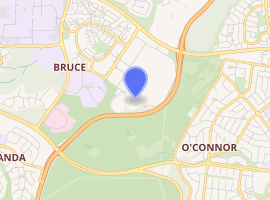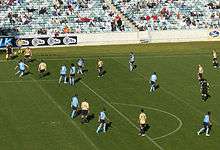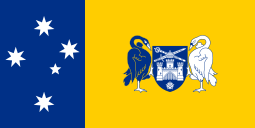Canberra Stadium
Canberra Stadium, known also as Bruce Stadium (for sponsorship reasons it is officially known as GIO Stadium Canberra, or simply GIO Stadium) is a facility primarily used for rugby league, soccer and rugby union games, located adjacent to the Australian Institute of Sport in Canberra, the capital of Australia. The GIO Stadium Canberra is the largest sports venue by capacity in Canberra.
 | |

| |
| Former names | Canberra Stadium Bruce Stadium National Athletics Stadium |
|---|---|
| Location | Bruce, ACT |
| Coordinates | 35°15′0″S 149°6′10″E |
| Owner | Australian Sports Commission |
| Capacity | 25,011[1] |
| Record attendance | 28,753 – Brumbies vs Crusaders, 2004 Super 12 Final |
| Surface | Grass |
| Construction | |
| Opened | 1977 |
| Architect | Phillip Cox & Partners |
| Tenants | |
| Rugby
Canberra Raiders (NRL) (1990–present) Canberra City SC (NSL) (1977–86) Other Tenants Canberra Bushrangers (ABL) (1993–95) | |
| Website | |
| giostadiumcanberra.com.au | |
History
Designed by architect Philip Cox[2] and constructed in 1977 for the Pacific Conference Games, it also was the venue for the 4th IAAF World Cup in Athletics. The main contractor was Leighton Contractors.[3]
At the latter meet, the still-current world record for the women's 400m was recorded by East German Marita Koch, and a world record for the women's 4 × 100 m was set by East Germany and stood until the 2012 London Olympic Games.
In the late 1980s the running track was removed and re-located to the warm up stadium at the AIS site. In the 1990 NSWRL season, the reigning NSWRL premiers the Canberra Raiders moved to Bruce Stadium from Seiffert Oval in Queanbeyan, their home ground since entering the NSWRL in 1982. The Raiders won their second straight premiership in 1990.
The removal of the track meant that Australian rules football, more specifically the Australian Football League (AFL), could now be played at the ground. In 1995, an AFL match for premiership points was contested between the West Coast Eagles and Fitzroy. There were also a number of pre-season AFL games played at the venue, mostly featuring the Sydney Swans.
Also around this time, as an experiment, a cricket pitch was placed in the centre of the ground, and a day/night 1 day cricket match was played between 2 local teams before a small crowd. Regular cricket matches on the ground did not eventuate.

Further renovations occurred in 1997 in preparation for staging soccer matches as part of the 2000 Summer Olympics in Sydney, which also in turn shrank the size of the playing field preventing any future Australian rules football games being played on the field. The final cost of the renovations was more than seven times what was originally anticipated by the territory government of the time, and the subsequent controversy ended the career of then Chief Minister Kate Carnell. During the lead-up, on 28 May 2000, unseasonal snow fell during a match between the Raiders and the Wests Tigers, the only such event in National Rugby League history, with the snow causing frost damage to the turf intended for the Olympic soccer tournament.
Olympic soccer in 2000 has initiated a stadium facelift converting the playing surface from oval to rectangular and bringing the crowd closer to the action.[4] The only downside to this revamp is the stadium can no longer host AFL games. It is now an all-seater rectangular stadium with two main grandstands on either side of the playing field. As a result, all top-class cricket and Australian rules football games in Canberra are now staged at the 15,000-capacity Manuka Oval.
A 2008 Rugby League World Cup game between Scotland and France was played at Canberra Stadium, the first ever rugby league test played at the venue. France defeated Scotland 36–16.
In 2009 there was an A-League bid from Canberra that, if successful would have seen an A-League team play at the stadium starting with the 2010–11 season. However, the league chose to award second teams to Sydney Rovers FC (which dissolved due to financial issues) and Melbourne Heart FC.
A new video screen was installed at the Southern end of the stadium in March 2020.[5]
Ownership
The stadium is currently owned by the Australian Government through the Australian Sports Commission and leased to the Australian Capital Territory Government. While the current lease is due to expire in 2010, the ACT Government is seeking ownership of the stadium through a land transfer with the Australian Government.
Seating and capacity
Capacity is a nominal all-seated 25,011, the largest crowd being 28,753 for the 2004 Super 12 Final. The main grandstand is named after Canberra Raiders and Australian rugby league player Mal Meninga, and a statue of another Raiders and Australian league representative Laurie Daley adorns the main grandstand entrance.
The eastern grandstand was named the Gregan/Larkham Grandstand on 28 April 2007, after Brumbies and Australia rugby union greats George Gregan and Stephen Larkham. Both ended their international careers after the 2007 Rugby World Cup as the two most-capped players in Wallabies history (at that time), with Gregan at a world-record 139 and Larkham at 102.
Crowd records
| Attendance | Date | Event |
|---|---|---|
| 28,753 | 22 May 2004 | 2004 Super 12 Final – ACT Brumbies vs Canterbury Crusaders |
| 27,489 | 27 May 2000 | 2000 Super 12 Final – ACT Brumbies vs Canterbury Crusaders |
| 26,567 | 27 September 2019 | 2019 NRL Preliminary Final – Canberra Raiders vs South Sydney Rabbitohs |
| 26,476 | 17 September 2010 | 2010 NRL Semi Final – Canberra Raiders vs Wests Tigers |
| 25,628 | 19 April 2013 | 2013 Anzac Test – Kangaroos vs Kiwis |
Possible replacement
Whilst the stadium suits the needs of its two current primary tenants, as of 2017 it is the smallest Super Rugby stadium and only a medium-sized NRL venue. The stadium itself is approaching 35 years old, and despite modernisations over the years is lacking in certain amenities for fans – especially covered seating.
Additionally, Australia had bid for the 2022 FIFA World Cup and Canberra Stadium does not meet the necessary criteria to host matches. As such, the ACT Government launched a study examining the upgrade or replacement of Canberra Stadium, with options ranging from increasing capacity and enclosing the current facility, to completely re-configuring the current stadium to an oval for cricket and Australian rules football and building a state of the art rectangular facility next door.[6]
Citing costs of building multiple facilities as an issue, ACT Sports Minister Andrew Barr indicated his preference would be a 'super stadium' built with World Cup standard facilities and capacity, able to be reduced to approximately 30,000 seats after the event. Such a facility would have to incorporate movable seating in order to accommodate all of the major Australian sporting codes.[7]
The official bid for the 2022 World Cup indicated that the 'super stadium' plan was unlikely and the original plan of a new rectangular stadium built next door to the current stadium, with the existing facility re-configured for oval field sports, was considered to be the likely outcome.[8]
After the failed World Cup bid a new rectangular covered stadium was proposed for Canberra.[9] In 2013 the ACT government announced plans to build a 30,000 covered (with a roof similar to Forsyth Barr Stadium) rectangular stadium in the city on the shores of Lake Burley Griffin. It would be part of a 15-year significant redevelopment of the foreshore which extends the city to the Eastern Basin. Along with the stadium, as part of the redevelopment there would be apartments, a convention centre and an urban beach.[10] Plans to build a new stadium have, however, been put on hold indefinitely due to the need for funds to compensate local residents over an asbestos home insulation debacle.[11] Plans to construct the new stadium have since been pushed back by a decade.[11]
Other notable events
- City vs Country rugby league match, 1981. City defeated Country 38-7 in front of 17,490 fans.
- In 1990, the stadium hosted an International Rules match (a combination of Gaelic football and Australian rules football) between Ireland and Australia. Ireland defeated Australia 52-31 in front of 7,000 fans.
- In 1992 the touring Great Britain Lions defeated the Canberra Raiders 24–12 in front of 4,728 fans.
- In 1995, the AFL's ailing Fitzroy Football Club played one home game against the West Coast Eagles at the venue. West Coast defeated Fitzroy 12.10 (82) to 8.6 (54) in front of 11,282 on 27 May.
- The 2nd leg of the 1996 OFC Nations Cup Final
- Super 12 Rugby union Final 2000, 2001, 2004
- Four group matches from the 2003 Rugby World Cup.
- The 2008 Pacific Schools Games
- One Group Match from the 2008 Rugby League World Cup.
- On 19 April 2013 the Stadium hosted the 2013 Anzac Test, the first time the Kangaroos had played a test in Canberra. Canberra Stadium was awarded the test as part of Canberra's centenary celebrations.
- Kanga Cup International youth soccer tournament.
- On 5 May 2017 the Stadium hosted the 2017 Anzac Test. This was the last Anzac Test to be played.
- Hosted three Group Matches from the 2017 Rugby League World Cup including the first Australia vs France test in Australia since 1994.
Concerts & International Matches
| Concerts | ||
|---|---|---|
| Date | Artist | Tour |
| 14 November 2012 | Elton John | 40th Anniversary of the Rocket Man |
| 10 December 2016 | Keith Urban and Carrie Underwood | Ripcord World Tour |
| 27 January 2019 | Keith Urban and Julia Michaels | Graffiti U World Tour |
| Rugby Union Test Matches | ||||||
|---|---|---|---|---|---|---|
| Date | Team #1 | Result | Team #2 | Event | Attendance | Referee |
| 22 September 1998 | Australia | 74–0 | 1999 Rugby World Cup qualifying | 14,176 | Steve Walsh | |
| 22 September 1998 | Fiji | 26–18 | 1999 Rugby World Cup qualifying | 14,176 | Steve Lander | |
| 24 June 2000 | Australia | 32–25 | 2000 Puma Trophy | 15,072 | David McHugh | |
| 15 October 2003 | Italy | 36–12 | 2003 Rugby World Cup Pool D | 18,967 | Steve Walsh | |
| 19 October 2003 | Wales | 27–20 | 2003 Rugby World Cup Pool D | 19,806 | Paul Honiss | |
| 21 October 2003 | Italy | 19–14 | 2003 Rugby World Cup Pool D | 20,515 | Paddy O'Brien | |
| 25 October 2003 | Italy | 15–27 | 2003 Rugby World Cup Pool D | 22,641 | Andrew Cole | |
| 13 June 2009 | Australia | 31–8 | 2009 mid-year rugby test series | 22,468 | Romain Poite | |
| 5 June 2010 | Australia | 49–3 | 2010 mid-year rugby test series | 15,438 | Peter Fitzgibbon | |
| 16 September 2017 | Australia | 45-20 | 2017 Rugby Championship / Puma Trophy | 14,229 | John Lacey | |
| Rugby league Test Matches[12] | ||||
|---|---|---|---|---|
| Test# | Date | Result | Attendance | Notes |
| 1 | 26 October 2008 | 9,287 | 2008 Rugby League World Cup Group B | |
| 2 | 19 April 2013 | 25,628 | 2013 Anzac Test | |
| 3 | 5 May 2017 | 18,535 | 2017 Anzac Test | |
| 4 | 29 October 2017 | 5,492 | 2017 Rugby League World Cup Group A | |
| 5 | 3 November 2017 | 12,293 | 2017 Rugby League World Cup Group A | |
| 6 | 10 November 2017 | 6,733 | 2017 Rugby League World Cup Group D | |
References
- "GIO Stadium (Canberra Stadium) - Austadiums". austadiums.com. Retrieved 15 October 2016.
- Bleby, Michael (20 August 2016). "Architect Philip Cox delivers upfront on architecture's deficiencies". Financial Review. Australia. Retrieved 20 August 2016.
- "Bruce Stadium & National Indoor Stadium Precinct / National Athletics Stadium & National Indoor Sports & Training Centre" (PDF). Australian Institute of Architects ACT Chapter: Register of Significant Architecture. Retrieved 4 January 2020.
- 2000 Summer Olympics official report. Archived 9 November 2000 at the Wayback Machine Volume 1. p. 392.
- "GIO Stadium Canberra". Facebook. Retrieved 4 August 2020.
- http://www.canberrastadium.com.au/about/masterplan.php
- "Archived copy". Archived from the original on 9 May 2010. Retrieved 9 May 2010.CS1 maint: archived copy as title (link)
- "Archived copy". Archived from the original on 6 July 2010. Retrieved 12 September 2010.CS1 maint: archived copy as title (link)
- Dutton, Chris. "City promised new stadium with roof by 2020". canberratimes.com.au. Retrieved 15 October 2016.
- Anderson, Larissa Nicholson and Stephanie. "Stadium, urban beach, convention centre on cards for Canberra CBD". canberratimes.com.au. Retrieved 15 October 2016.
- Dutton, Chris. "Mr Fluffy clean-up and delayed new stadium in Canberra could affect chances of hosting Wallabies Tests". The Sydney Morning Herald. Retrieved 15 October 2016.
- Ferguson, Shawn Dollin and Andrew. "Bruce Stadium - Bruce Stadium - Rugby League Project". rugbyleagueproject.org. Retrieved 15 October 2016.
External links
| Wikimedia Commons has media related to Canberra Stadium. |
- Official site
- Canberra Stadium at Austadiums

